There is no universal theory of image segmentation. With the introduction of many new theories and new methods in various disciplines, many image segmentation methods have been developed that combine some specific theories and methods.
Cluster analysisThe feature space clustering method performs image segmentation by representing pixels in the image space with corresponding feature space points, segmenting the feature space according to their aggregation in the feature space, and then mapping them back to the original image space to obtain the segmentation result. Among them, K-means and fuzzy C-means clustering (FCM) algorithm are the most commonly used clustering algorithms. The K-means algorithm first selects K initial class means, then classifies each pixel into the class closest to it and calculates a new class mean. Iterate through the previous steps until the difference between the old and new class mean is less than a certain threshold. The fuzzy C-means algorithm is a generalization of the K-means algorithm on the basis of fuzzy mathematics. It is achieved by optimizing a fuzzy objective function to achieve clustering. It does not think that each point can belong to a certain class, just like K-means clustering. Give each point a degree of membership to each category, and use the degree of membership to better describe the characteristics of the edge pixels, which is suitable for dealing with the inherent uncertainty of things. Image segmentation using the characteristics of fuzzy C-means (FCM) unsupervised fuzzy clustering calibration can reduce human intervention and is more suitable for the characteristics of uncertainty and ambiguity in the image.
The FCM algorithm is extremely sensitive to the initial parameters, and sometimes requires manual intervention of the parameters to approximate the global optimal solution and improve the segmentation speed. In addition, the traditional FCM algorithm does not consider spatial information and is sensitive to noise and grayscale inhomogeneities.
Fuzzy set theory
Fuzzy set theory has the ability to describe the uncertainty of things and is suitable for image segmentation problems. Since 1998, many fuzzy segmentation techniques have appeared, and their applications in image segmentation have become increasingly widespread. A distinctive feature of fuzzy technology in image segmentation is that it can be combined with many existing image segmentation methods to form a series of integrated fuzzy segmentation techniques, such as fuzzy clustering, fuzzy threshold, and fuzzy edge detection techniques.
The fuzzy threshold technique uses different S-type membership functions to define the fuzzy target, and finally selects an S function with the smallest uncertainty through the optimization process. This function is used to enhance the relationship between the target and the pixels belonging to the target, and the intersection of the obtained sigmoid function is the threshold required for threshold segmentation. The difficulty of this method lies in the selection of the membership function. The segmentation method based on fuzzy set and logic is based on fuzzy mathematics, which utilizes the uncertainty problem caused by incomplete, inaccurate, vague, contradictory information in the membership image. This method has been widely used in medical image analysis. For example, a new thresholding algorithm based on inter-image fuzzy divergence proposed by Xue Jinghao et al. and its generalization algorithm in multi-threshold selection, using fuzzy sets to express segments separately Before and after the image, the optimal extraction of the optimal threshold in image segmentation is achieved by the minimum fuzzy divergence criterion. The algorithm constructs a new fuzzy membership function for the image thresholding segmentation, which overcomes the influence of the traditional S function bandwidth on the segmentation effect. It has good versatility and effectiveness, and the scheme can realize segmentation quickly and correctly. It is not necessary to determine the number of split classes in advance. The experimental results are satisfactory.
Analysis of the principle and method of image segmentationone. Research background and significance
Research Background:
With the development of artificial intelligence, robot technology is continuously applied to various fields. The addition of information technology is a necessary prerequisite for the emergence of intelligent robots. Information technology generally refers to a large class of technologies including communication technology, electronic technology, signal processing technology and other related information technology. Its application has brought about tremendous changes in people's lives today. The emergence of household appliances such as mobile phones to high-definition televisions has made our lives more and more colorful. In some military and civilian fields, high-tech such as image guidance, unmanned aircraft, unmanned patrol cars, face recognition, fingerprint recognition, speech recognition, vehicle license plate recognition, Chinese character recognition, and medical image recognition have appeared in recent years. The core to achieve them is image processing, machine vision, pattern recognition, intelligent control, and robotics. Among them, image processing has an important position. Image segmentation technology is the key technology in image analysis.
Study the significance of image segmentation technology:
The two major ways for humans to perceive the outside world are hearing and vision, especially vision. At the same time, visual information is the main source of information that humans obtain from nature, accounting for more than 80% of human access to information in the outside world. The image is directly based on the visual system to obtain the state of the objective world. It directly or indirectly acts on the human eye, and the reflected information is consistent with the information obtained by the human eye. This determines that it and the objective outside world are the most important information of human beings. Source and image processing have therefore become one of the hotspots of people's research. The information obtained by the human eye is a continuous image. In practical applications, in order to facilitate processing of images by a computer or the like, people process and quantize successive images to obtain digital images that can be recognized by a computer. Digital images have the advantages of large amount of information, high precision, rich content, and can perform complex nonlinear processing, which has become an important research object of computer vision and image processing. In an image, people tend to be interested in only some of them, called foreground, and some spatial information characteristics (such as grayscale, color, outline, texture, etc.) in these areas are usually between the surrounding background. There are differences. Image segmentation is the technique and process of dividing an image into specific regions with unique properties based on these differences and extracting the target of interest. Image segmentation is a very important step in early processing of digital image processing. In order to facilitate the study of image segmentation and its effective application in actual image processing, it is necessary to strictly define the concept of image segmentation. The mathematical description of image segmentation is generally: the entire image domain R of the image I is divided into N disjoint sub-subjects according to the similarity measurement logic criterion P: Condition 1 ensures that the sum of all the segmentation regions is equal to the entire image region; Condition 2 It is guaranteed that there is no overlap between different regions; Condition 3 ensures that the image features in the same region are consistent; Condition 4 ensures that the image features of different divided regions are different.
So far, researchers have made a lot of research results in the field of image segmentation. These results are derived from the use of different features in the image, such as the similarity of features in the same region and the connectivity between pixels, targets and There are discontinuities between the backgrounds, etc., but so far no segmentation algorithm can be used for all image segmentation, which also promotes the researchers to continuously study image segmentation. Most of the early classic image segmentation methods only use the low-level information of the image, such as edge, texture, grayscale, etc. Among them, the more classical algorithms include image segmentation based on 阂 value, image segmentation based on edge detection, image segmentation based on graph theory, etc. . In recent years, researchers have shifted the focus of research to high-level knowledge in images, and introduced prior knowledge into image segmentation algorithms, and obtained some new image segmentation concepts, such as wavelet transform fuzzy sets [fgl mathematical morphology, neural The network activity contour model and the like enrich the image segmentation method and greatly improve the segmentation effect.
Image segmentation is an important part of image processing and computer vision. In recent years, it has not only been a hot topic in the field of computer vision, but also widely used in real life. For example, in medicine, it is used to measure tissue volume, three-dimensional reconstruction, surgical simulation, etc. in medical images; in remote sensing images, segmentation of targets in synthetic aperture radar images, extraction of different cloud systems and backgrounds in remote sensing clouds, positioning of satellite images Roads and forests, etc. Image segmentation can also be used as pre-processing to transform the original image into several more abstract and more computer-friendly forms, which preserves important feature information in the image, effectively reduces useless data in the image, and improves subsequent image processing. Accuracy and efficiency. For example, in terms of communication, the contour structure, the regional content, and the like of the target can be extracted in advance, and the image can be compressed in a targeted manner while improving the network transmission efficiency without losing useful information; in the traffic field, the contour can be extracted from the vehicle. Identify or track, pedestrian detection, etc. In general, all aspects related to the detection, extraction and recognition of the target require the use of image segmentation techniques. Therefore, it is of great significance to study and discuss image segmentation from the aspects of image segmentation techniques and algorithms, as well as from image processing, computer vision and practical applications.
two. Common techniques for image segmentation1. Basic concept of image segmentation
Image segmentation definition: Image segmentation divides an image into a number of disjoint and certain regions according to certain rules. The parts of interest are extracted from the image and further researched, analyzed and processed. The result of image segmentation is the basis of image understanding such as image feature extraction and recognition. Research on image segmentation has always been a hotspot and focus in the research of digital image processing technology. Image segmentation enables the amount of data to be processed in subsequent advanced stages of image analysis, recognition, and the like to be greatly reduced while retaining information about image structure features. Image segmentation has other names in different fields, such as target contour technology, target detection technology, thresholding technology, target tracking technology, etc. These technologies or their cores are actually image segmentation technologies.
Image segmentation purpose: divide the image space into meaningful regions and various objects in the image
The target corresponds. The information contained in the image can be understood by describing the segmentation result.
Classification of image segmentation: Image segmentation is the process of classifying pixels. The basis of classification can be established: the similarity and discontinuity between pixels.
2. Edge-based image segmentation method
Edges always appear as sudden changes in intensity and can be defined as discontinuities in the local characteristics of the image, such as mutations in grayscale, mutations in texture structures, and so on. Edges often mean the end of one area and the beginning of another. The detection of edges is often done by means of a spatial differential operator, by convolving its template with the image. There are always grayscale edges between two adjacent regions with different gray values, and this is the result of the discontinuity of the gray values, which can be detected using the first and second derivatives. In today's edge detection methods, there are mainly one differential, two differential and template operations. These edge detectors can achieve better results for less complex images such as sharper gray edges and less noise. However, it is not ideal for complex image edges, such as edge blurring, edge loss, and edge discontinuity. The presence of noise makes the effect of the derivative-based edge detection method significantly lower. In the case of large noise, the edge detection operator usually first smoothes the image appropriately, suppresses the noise, and then obtains the derivative or localizes the image. Fit, and replace the direct numerical derivative with the derivative of the fitted smooth function, such as the Canny operator. In future research, adaptive threshold selection for extracting initial edge points, selection of larger regions for image hierarchical segmentation, and how to identify important edges to remove false edges will be very important.
According to the characteristics of grayscale changes, common edges can be divided into step type, roof type and flange type edge detection methods, mainly the following:
1. The spatial domain differential operator is also the traditional edge detection method. Such as Roberts operator, Prewitt operator and Sobel operator.
2. Fit the surface. The method fits a surface using some pixel values ​​in the current pixel neighborhood and then finds the gradient of this continuous surface at the current pixel. 3. Wavelet multi-scale edge detection. 4. Edge detection based on mathematical morphology.
Finally, the target area is determined by the contour (boundary) tracking of the image:
The contour (boundary) tracking of an image is closely related to edge detection because contour tracking essentially "walks" a circle along the outer edge of the image and then segments the target area.
The following figure shows the results of grayscale Lena image segmentation using Roberts, Sobel, Prewitt, LOG, and Canny operators, respectively:
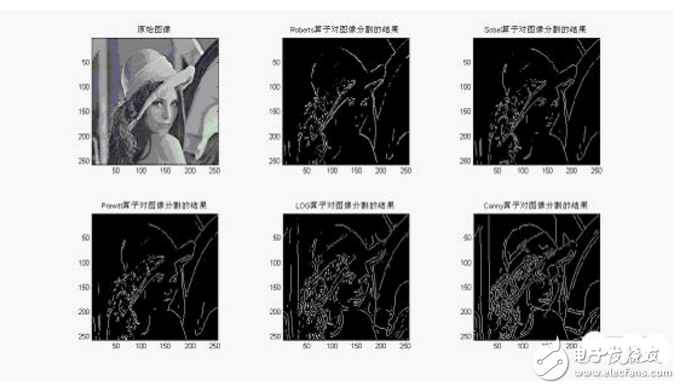
3. Threshold segmentation method
Threshold segmentation is a common algorithm for directly segmenting an image, depending on the grayscale value of the image pixels. For a single target image, you only need to select a threshold to divide the image into two categories: target and background. This is called single threshold segmentation. If the target image is complex, multiple thresholds can be selected to target the region and background in the image. It is divided into multiples. This is called multi-threshold segmentation. At this time, it is necessary to distinguish the image targets in the detection results, and distinguish each image target region by unique identification. The significant advantages of threshold segmentation are low cost and simple to implement. When the pixel gray value or other features of the target and background regions are significantly different, the algorithm can achieve image segmentation very effectively. The key to the threshold segmentation method is how to obtain a suitable threshold. In recent years, the methods of selecting the threshold with the principle of maximum correlation, the method based on image topological stability state, the gray level co-occurrence matrix method, the maximum entropy method and the peak-to-valley value Analytical methods, etc., in more cases, the choice of thresholds will use two or more methods in combination, which is also a trend in the development of image segmentation.
Threshold method is a more traditional image segmentation algorithm. The algorithm differs in the gray value between the target area and the background of interest, and has a uniform gray value in the area. The image is divided into multiple regions by setting one or more thresholds.
The threshold method mainly includes two steps of selecting a 阂 value and a comparison, which is to determine the region to which the pixel belongs by comparing the gray value and the 阂 value of each pixel in the image. Therefore, the selection of the threshold is the key to the algorithm. According to different ways of determining the 阂 value, the algorithm can be divided into two categories: global 分割 value segmentation and local 阂 value segmentation. The global threshold segmentation method is to classify the pixels in the image by selecting a threshold value that is most favorable for segmenting the target edge. Common global threshold segmentation includes bimodal method, Otsu, minimum error method, etc. The local threshold segmentation method first decomposes the entire image domain into several small regions, and selects the 阂 value pair suitable for the region within each small region. It splits and merges the small areas. Common local threshold divisions include the Niblaek method and the Bernsen method. In recent years, researchers have also proposed some improved threshold algorithms. For example, Long Jianwu proposed an adaptive threshold algorithm based on Gaussian scale space. The algorithm uses Gaussian function to obtain Gaussian scale space for image convolution, and then uses background difference method to eliminate the influence of gray unevenness. Finally, the largest class is used. The variance gets the threshold. Wen Jiangtao proposed an improved algorithm combining Curvelet transform and Otsu method. The algorithm firstly enhances the curvelet coefficient by nonlinear function to eliminate the edge inhomogeneity problem in the image, and then uses Otsu algorithm to segment the image. The threshold-based image segmentation algorithm is simple and easy to implement, and has high efficiency. However, in the actual image, the gray level of the target or background tends to be unevenly distributed, and there is overlapping gray scale between the target and the background, which causes over-segmentation or under-segmentation in the segmentation result of the 阂-value method.
The method of using only one threshold segmentation is called a single threshold segmentation method.
If there are multiple regions in the image with different gray values, then a series of thresholds can be selected to classify each pixel into the appropriate category. This method of segmentation with multiple thresholds is called a multi-threshold segmentation method.
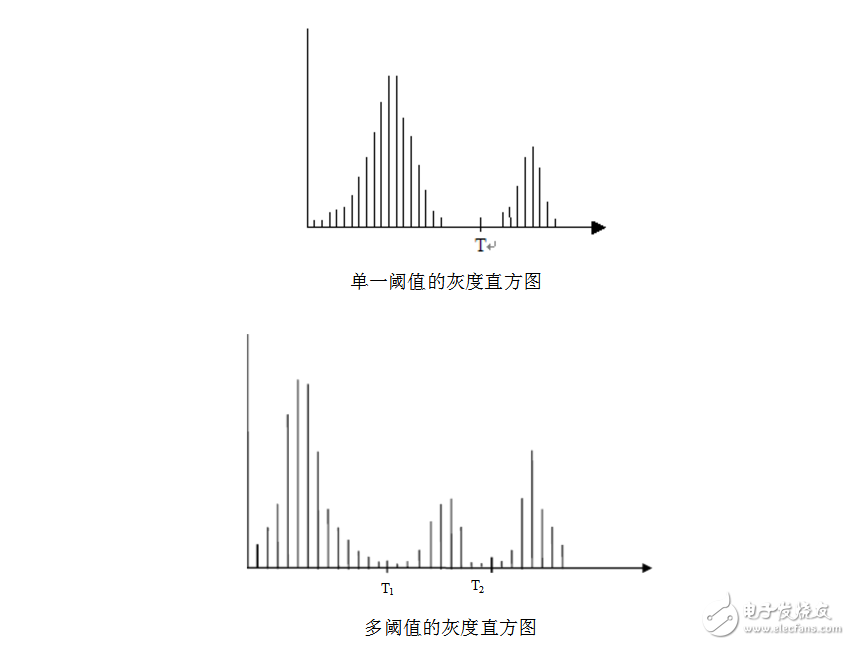
The threshold is selected based on:
1. Depending on the gray value of the image, only the threshold associated with the nature of each image pixel itself is selected - the global threshold.
2. Depending on the gray value of the image and some local characteristics of the neighborhood of the point, ie the threshold selection associated with the local area characteristics - the local threshold.
3. In addition to depending on the gray value of the image and some local characteristics of the neighborhood of the point, it also depends on the spatial coordinates, ie the resulting threshold is related to the coordinates - the dynamic threshold or the adaptive threshold. Global threshold
Principle: Assume that the object and the background are at different gray levels, and the image is contaminated by zero-mean Gaussian noise. The gray distribution curve of the image is approximated by two normal distribution probability density functions representing the histogram of the target and the background, respectively. The composite curve of the function fits the histogram of the overall image. The histogram of the image will show two separate peaks. The following figure then finds the gray value corresponding to the valley between the two peaks of the histogram according to the minimum error theory. The threshold of the segmentation.
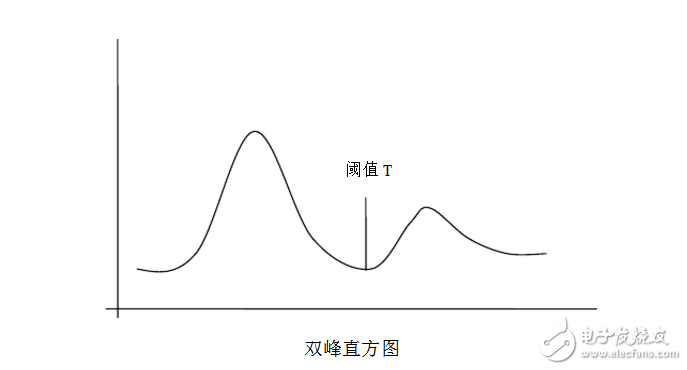
This method is suitable for images with good bimodal properties, but requires numerical approximation and other calculations. The algorithm is very complicated, and the histograms of most images are discrete and irregular.
In the actual threshold segmentation process, it is often necessary to automatically obtain the threshold. The following algorithm can automatically obtain the global threshold:
1) Select an initial estimated value T;
2) Split the image with T. This produces two sets of pixels: G1 consists of all pixels whose gray value is greater than T, and G2 consists of all pixels whose gray value is less than or equal to T.
3) Calculate the average gray values ​​u1 and u2 for all the pixels in G1 and G2. 4) Calculate the new threshold: T = 1/2 (u1 + u2).
Steps (2) through (4) are repeated until the difference in the obtained T values ​​is less than a previously defined parameter T. The following figure is the result of image segmentation by iterative threshold selection method and Otsu (the method of selecting threshold value by the principle of maximum correlation). The results of image segmentation of threshold selection method are similar.
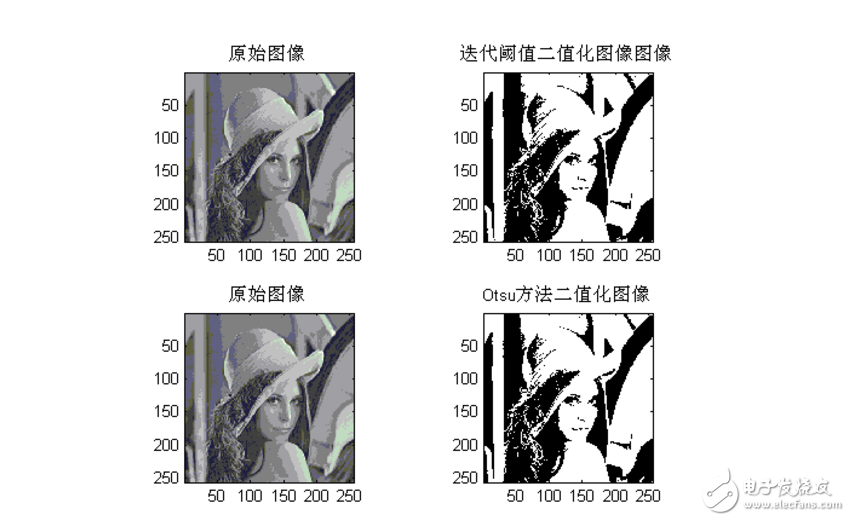
4. Area segmentation method
The regional growth method and the split-merging method are the main methods for image segmentation based on regional information. There are two ways to increase the area. One is to divide the image into many small areas with strong consistency, and then merge the small areas into large areas according to certain rules to achieve the purpose of segmenting the image. Another implementation is to specify a seed region in the image to be segmented, and then add surrounding pixels to the seed region according to a certain rule, and finally achieve the purpose of separating the target from the background; splitting and merging the image The segmentation is performed in the opposite direction by the region growing method, and there is no need to set a seed point. The basic idea is to give similar measures and homogenous measures. Starting from the entire image, if the region does not satisfy the homogenous measure, it splits into non-overlapping sub-regions of arbitrary size, and merges if the sub-regions of the two neighborhoods satisfy the similarity measure.
Regional growth is the most basic method of regional segmentation. The so-called area growth is a process of aggregating pixels or sub-areas into larger areas according to pre-defined criteria.
Basic idea:
Start with a set of growth points (which can be a single pixel or a small area), search for its neighborhood, divide the image into several regions with similar features, and compare the similarity between adjacent regions and growth point features. When they are similar enough, they merge as the same area to form a new growth point. In this way, regions with similar features are continuously merged until they cannot be merged, and finally regions with different features are formed. This method of segmentation is also called the regional expansion method.
In practical applications, there are three problems to be solved: 1) determining the number of regions, that is, selecting a set of growth point pixels that correctly represent the desired region;
2) Select meaningful features, that is, determine the inclusion of adjacent area pixels during the growth process.
the way;
3) Determine the similarity criterion, that is, the criteria for stopping the growth process.
Feature similarity is the basic criterion for constituting and merging regions, and contiguousness refers to the neighborhood method taken. Different regional growth methods are produced depending on the neighborhood mode and similarity criteria used.
The gray-scale correlation value is used as the region growth criterion, and the region growth can be divided into a single type (pixel and pixel), a centroid type (pixel and area), and a mixed type (area and area). The principle of single-type regional growth method:
A certain pixel of the image is used as a growth point, and adjacent pixels with similar features are merged into the same region; then the merged pixel is used as a growth point, and the above operations are repeated to finally form a maximum connected set of pixels having similar features.
The steps of simple region growth characterized by pixel gradation are given below.
(1) Raster scan the image to find out which pixels are not yet owned. The operation ends when such a pixel is not found.
(2) Compare the gray level of this pixel with the pixels around it (4-neighbor or 8-neighbor) that do not belong to any area. If the gray level difference is less than a certain threshold, merge them into the same area. And assign a label to the merged pixels.
(3) Starting from the newly merged pixels, the operation of (2) is repeated until the regions cannot be merged again. (4) Return to the (1) operation and look for pixels that can serve as the starting point for the new area. Advantages and disadvantages:
This method is simple, but if the edge grayscale changes between regions are smooth or the edges intersect at a point, the two regions will merge. Solution:
To eliminate this, in step (2), instead of comparing adjacent pixel gradations, the pixel gradation average of the existing region is compared with the pixel gradation value adjacent to the region.
The following figure compares the results of regional growth method image segmentation with three growth points and the results of region growth method image segmentation with three different growth points.
The growth point of the first subgraph is the abscissa [30, 40, 82] ordinate [56, 30, 35]. The growth point of the second subgraph is the abscissa [63, 10, 85] ordinate [30, 56, 60]. The growing point is represented by a green square in the first image
As can be seen from the comparison, the shortcoming of the regional growth method is that the segmentation result is determined by the choice of growth point.
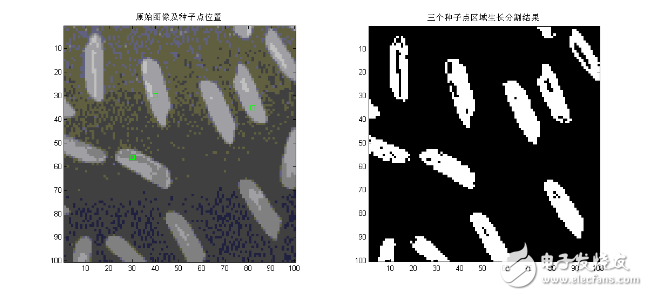
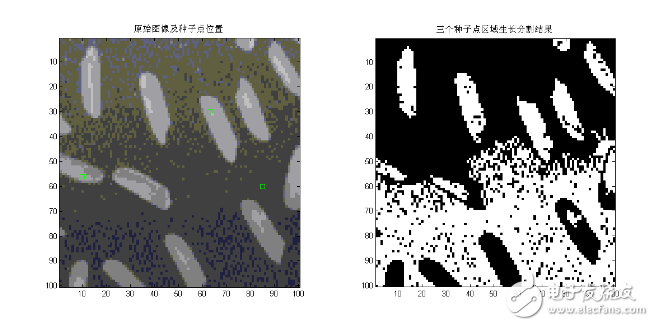
Although the research results of image segmentation are more and more in recent years, due to the difficulty of image segmentation, there are still some problems in research. Many existing algorithms are aimed at different images, and there is no universal application. Segmentation algorithm. So far, there is no good general-purpose segmentation evaluation standard. How to quantify the segmentation result is a problem worthy of study. The quantitative measure should help the automatic decision-making and evaluation algorithm in the visual system. Factors such as homogeneity, contrast, compactness, continuity, and psycho-visual perception should be considered. With the continuous expansion of the application field of digital image processing, real-time processing technology has become a research hotspot. In real-time image processing systems, The running time of the algorithm has also become the direction and goal of future research.
Although there is no general theory for image segmentation, in recent years, a large number of scholars have devoted themselves to the application of new concepts and methods to image segmentation. The image segmentation method combined with specific theory has achieved good application results in image segmentation. The use of mathematical tools such as wavelet analysis and wavelet transform, neural network, genetic algorithm, etc., effectively improves the segmentation effect.
The image segmentation method is to connect adjacent pixels to form an area, and pixels in the same area must have some similarity. This kind of segmentation method often establishes the connection according to the gray value, texture, statistical features and color of the pixel, and ensures similarity and continuity in the same region, but the advantages and disadvantages of the segmentation show strong similarity conditions. Dependence, and the segmentation result is prone to over-segmentation. Region-based image segmentation methods mainly include split merging and region growing. The splitting and merging method first splits the entire image, and then judges the similarity of the split region by some criteria, and merges the adjacent similar split regions to obtain the segmentation result. The regional growth method needs to set the principle of similarity and the growth seed in advance. From the growth seed, the adjacent pixels satisfying the principle of similarity are continuously merged to form a region, and the purpose of image segmentation is achieved by dividing the region, the most important of which is the similarity. The setting of principles and the selection of growing seeds. ZhuSong et al. proposed a segmentation method that combines the geometric features of the Snake model with the statistical features of regional growth. The algorithm first uses region growing to segment several regions of the image, and then uses Bayesian and the minimum description length for regional competition. The area where the seed is located, so that the correct segmentation image is obtained. Zhang et al. proposed an adaptive split-merging clustering algorithm, which adaptively splits and merges clusters by defining spatial connectivity and using mid-perpendicular segmentation.
The region-based image segmentation technique is mainly used to identify regions with similar characteristics in images, requiring pixels of the same region to have similar features and connectivity, and as such, it has the ability to eliminate isolated noise points. However, the regional growth method requires high selection of seed points, and the selected results will directly affect the effect of image segmentation. Although the splitting method does not need to choose the seed point for growth, there is a big contradiction between the segmentation effect and the degree of division. When the split is relatively sufficient, it has a better segmentation effect, but the time and workload of the segmentation will increase. Large; to improve efficiency can only reduce the division work, which will affect the quality of the segmentation
1. Image segmentation based on genetic algorithm
Genetic algorithm is a kind of self-organizing and adaptive artificial intelligence technology that simulates the evolution process and mechanism of natural biological processes. In this regard, scientists have done a lot of research work and successfully applied to various types of optimization problems. When segmenting complex images, people often use multi-parameters for information fusion, and obtain the optimal value of multi-parameter participation. In the process, optimization calculation is the most important. Applying the characteristics of natural evolution to computer algorithms will solve many problems. The emergence of genetic algorithms provides a new and effective way to solve such problems, not only can get the global optimal solution, but also greatly shorten the calculation time. Wang Yuelan et al. proposed a color image segmentation method based on information fusion technology. This method uses the shelling technique to reduce the complexity of the problem, and then applies the information fusion technology to color image segmentation to provide applications for color segmentation in different fields. A new idea and solution.
2. Image segmentation based on artificial neural network technology
The basic idea of ​​the segmentation method based on neural network is to first obtain the linear decision function by training the multi-layer perceptron, and then use the decision function to classify the pixels to achieve the purpose of segmentation. In recent years, with the research and development of neurology, the third generation of pulse coupled neural network (PCNN) as a new artificial neural network model, its unique processing method provides a new idea for image segmentation. The pulse-coupled neural network has a capture characteristic that generates ignition pulse propagation and has a spatio-temporal integration effect on the input image, and adjacent neurons with similar inputs tend to ignite simultaneously. Therefore, for grayscale images, the PCNN has a natural segmentation capability, and neurons corresponding to different target regions in the input image are fired at different times, thereby separating the different regions. If the gray-scale distribution of the target area overlaps, due to the spatial-temporal integration of PCNN, if the gray-scale distribution conforms to a certain rule, the PCNN can overcome the adverse effects caused by the overlapping of the gray-scale distribution, thereby achieving a perfect segmentation. This is a prominent advantage, and this is precisely what other segmentation methods lack, which will play a leading role in future image segmentation.
3. Image segmentation and multi-resolution analysis based on wavelet analysis and transformation have been widely used in image processing and other fields. Wavelet transform is a multi-scale multi-channel analysis tool, which is more suitable for multi-scale edge detection of images. From image
From the processing point of view, the wavelet transform has the "zoom" feature, high frequency resolution and low time resolution are available in the low frequency band, low frequency resolution and high time resolution are available in the high frequency band, and there are many fast algorithms for implementing wavelet switching. Resolution, also called multi-scale features, can be used to observe the signal gradually and coarsely. In recent years, multi-ary wavelets have also begun to be used for edge detection. In addition, the image segmentation technique combining wavelet transform and other methods is also a hot topic of research.
In recent years, wavelet theory has developed rapidly, and because of its good time-frequency localization
Power 30W ,output voltage 3-12V, output current Max 1.2A , USB output 5v 2a, 6 dc tips. We can meet your specific requirement of the products, like label design. The material of this product is PC+ABS. All condition of our product is 100% brand new.
Our products built with input/output overvoltage protection, input/output overcurrent protection, over temperature protection, over power protection and short circuit protection. You can send more details of this product, so that we can offer best service to you!
30W Wall Adapter ,30W Wall Power Supply,30W Power Cord In Wall, 30W Wall Power Adapter
Shenzhen Waweis Technology Co., Ltd. , https://www.waweispowerasdapter.com